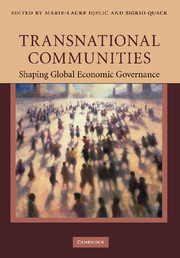Book contents
- Frontmatter
- Contents
- List of figures
- List of tables
- List of appendices
- Contributors
- Preface
- Part I Introduction
- Part II Classical communities with a transnational extension
- Part III Professional communities with a transnational extension
- Part IV Virtual communities
- Part V Transnational interest- or issue-based communities
- 11 The transnational temperance community
- 12 Industrial democracy in the European Community: trade unions as a defensive transnational community, 1968–1988
- 13 The making of a comprehensive transnational discourse community trade unions as a defensive transnational community, 1968–1988
- 14 Global warming, transnational communities, and economic entrepreneurship: the case of carbon capture and storage (CCS)
- 15 Communities of practice as cause and consequence of transnational governance: the evolution of social and environmental certification
- Part VI Conclusion
- Index
- References
15 - Communities of practice as cause and consequence of transnational governance: the evolution of social and environmental certification
Published online by Cambridge University Press: 07 September 2010
- Frontmatter
- Contents
- List of figures
- List of tables
- List of appendices
- Contributors
- Preface
- Part I Introduction
- Part II Classical communities with a transnational extension
- Part III Professional communities with a transnational extension
- Part IV Virtual communities
- Part V Transnational interest- or issue-based communities
- 11 The transnational temperance community
- 12 Industrial democracy in the European Community: trade unions as a defensive transnational community, 1968–1988
- 13 The making of a comprehensive transnational discourse community trade unions as a defensive transnational community, 1968–1988
- 14 Global warming, transnational communities, and economic entrepreneurship: the case of carbon capture and storage (CCS)
- 15 Communities of practice as cause and consequence of transnational governance: the evolution of social and environmental certification
- Part VI Conclusion
- Index
- References
Summary
When communities of organic farmers began certifying ecologically friendly agriculture, they could never have guessed how prominent the certification model would become. Nearly four decades later, consumers can buy products not just from certified farms, but also certified forests, fisheries, and factories – with standards pertaining not only to the environment, but also to “social” conditions of labor and community development. Firms interested in “corporate social responsibility” and “ethical sourcing” can now draw on a growing set of suppliers whose labor or environmental standards have been certified by an independent body. For their part, the certification associations that oversee this activity – the Fairtrade Labeling Organization, Forest Stewardship Council, Social Accountability International, and others – find themselves entwined in an increasingly elaborate web of transnational governance, layered with evolving rules about trade and standard-setting, competing initiatives, and a variety of questions about the legitimacy and effectiveness of their activities. Certification of quality and product safety has, of course, existed for many years (Cheit 1990), but the transformation of certification into a mode of social/environmental regulation has occurred mainly since the 1990s.
Most observers of certification initiatives have focused on a single sector or issue domain. Thus, we have a range of studies of forest certification, organic agriculture, Fair Trade certification, labor standards monitoring, and the sustainable management of fisheries. More general theories of this form often portray it as a solution to several types of problems.
- Type
- Chapter
- Information
- Transnational CommunitiesShaping Global Economic Governance, pp. 347 - 374Publisher: Cambridge University PressPrint publication year: 2010
References
- 35
- Cited by

